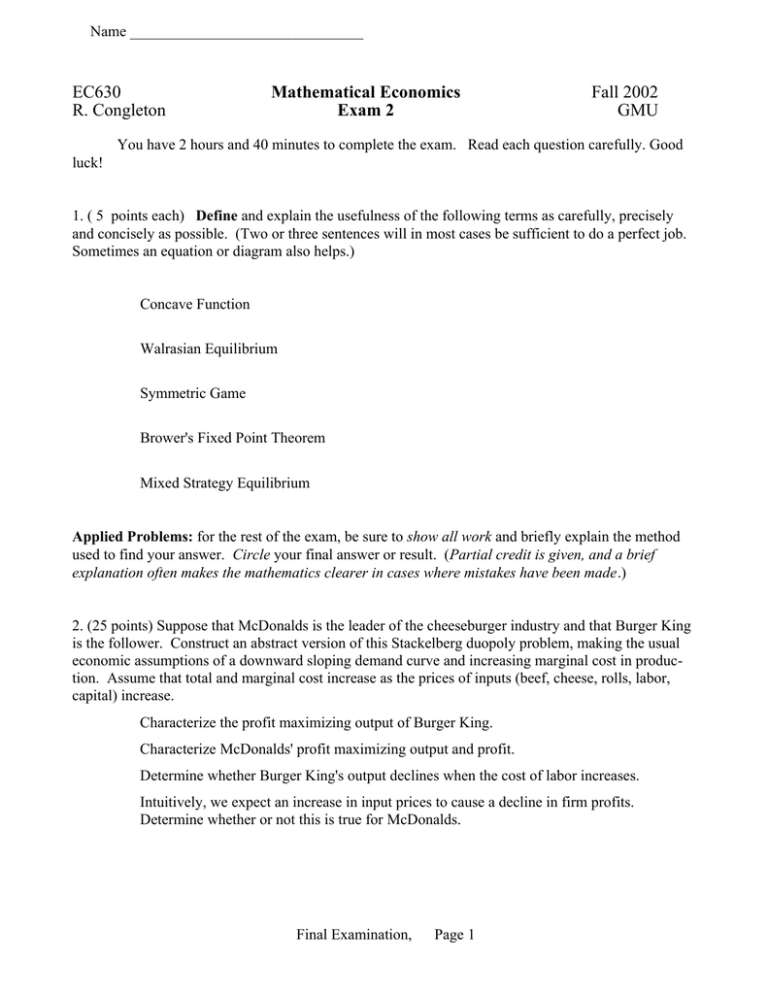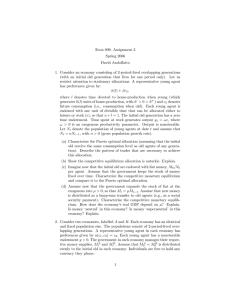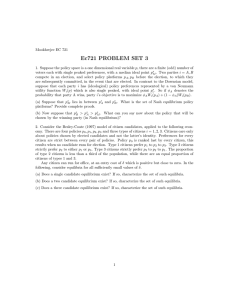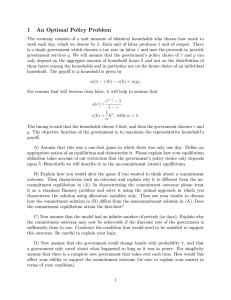EC630 Fall 2002 R. Congleton GMU
advertisement

Name _______________________________ EC630 R. Congleton Mathematical Economics Exam 2 Fall 2002 GMU You have 2 hours and 40 minutes to complete the exam. Read each question carefully. Good luck! 1. ( 5 points each) Define and explain the usefulness of the following terms as carefully, precisely and concisely as possible. (Two or three sentences will in most cases be sufficient to do a perfect job. Sometimes an equation or diagram also helps.) Concave Function Walrasian Equilibrium Symmetric Game Brower's Fixed Point Theorem Mixed Strategy Equilibrium Applied Problems: for the rest of the exam, be sure to show all work and briefly explain the method used to find your answer. Circle your final answer or result. (Partial credit is given, and a brief explanation often makes the mathematics clearer in cases where mistakes have been made.) 2. (25 points) Suppose that McDonalds is the leader of the cheeseburger industry and that Burger King is the follower. Construct an abstract version of this Stackelberg duopoly problem, making the usual economic assumptions of a downward sloping demand curve and increasing marginal cost in production. Assume that total and marginal cost increase as the prices of inputs (beef, cheese, rolls, labor, capital) increase. Characterize the profit maximizing output of Burger King. Characterize McDonalds' profit maximizing output and profit. Determine whether Burger King's output declines when the cost of labor increases. Intuitively, we expect an increase in input prices to cause a decline in firm profits. Determine whether or not this is true for McDonalds. Final Examination, Page 1 Name _______________________________ 3. (25 points) Suppose that coal-fired generators in China and the United States are the principal (human) source of greenhouse gases. Assume that the average temperature in both countries (T) increases with the total greenhouse gas emissions (E) from burning coal, T = t(EUS + EChina ). Suppose further that environmental policy making in both countries can be modelled as an effort to maximize a single policy maker's (i's) strictly concave utility function defined over national income and average temperature, Ui = u(Yi, T). The relevant policy maker's income falls as environmental regulations increase over the range of interest, so YUS = yUS(RUS) and YChina = yChina(RChina). Environmental regulations in each country reduce emissions, but only within the country regulated. Characterize the environmental regulation adopted by the US. Determine how the environmental regulations adopted by the US are affected by those adopted by China. Do the US regulations become more or less intense as Chinese regulations become more intense? Draw a diagram that depicts the Nash equilibrium of this environmental regulation game. (Be sure to label all important details.) Is this Nash Equilibrium Pareto optimal? Show and/or explain. (4.) (25 points) Suppose that individuals value only health, H, transport services, T, and other personal consumption, C, so that U=u(H, T, C). Automobile size (S) and gasoline (G) are inputs into the household production of transport services, T = t( S, G), with T increasing as G increases but decreasing as S increases. The individual of interest, Al, has W dollars to allocate between C, S, and G which are purchased in competitive markets. However, gasoline consumption is a monotone increasing function of the automobile's size and travel, so G=g(S,T). Travel is a bit risky. The probability of an accident increases with travel, P = p(T), but the health damage generated falls as automobile size increases, so Al's health can be modelled as H = Ho - d(S), other things being equal. If no accident occurs, Al's health is unaffected by driving, so H = H0 Characterize Al's expected utility maximizing automobile size. Explain your results briefly and the assumptions that you have made. How far does Al drive (T)? Does Al's short run demand for gasoline necessarily slope downward when Al's utility function is separable and strictly concave? (Hint: the demand for gasoline is determined by T in the short run.) Briefly explain your analysis. Have a Nice Winter Holiday! Final Examination, Page 2








